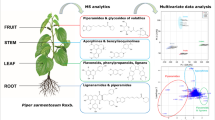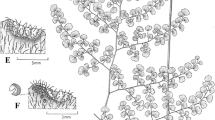Abstract
The leaf waxes of 23 woody bamboo species of three subgenera, Dendrocalamus, Bambusa and Dendrocalamopsis, from the Xishuangbanna tropical rain forest in Southwest China were analyzed by gas chromatography and coupled gas chromatography–mass spectrometry. The waxes of the Dendrocalamus species are dominated by C27 and C29 n-alkanes and their average chain length (ACL) has an average of 28.3. In marked contrast to the Dendrocalamus species, the wax composition of the Bambusa species is characterized by a broad distribution of major n-alkanes from C27 to C35, greater ACL values (>29) and an enhanced relative abundance (>30%) of n-alkanes with a carbon number greater than 30. Unlike the Dendrocalamus species and the Bambusa species, the Dendrocalamopsis species do not have a distinct n-alkane distribution; in some species the n-alkane distribution is comparable to that in the Bambusa species and in others to that in the Dendrocalamus species. The lipid data suggest that it might be reasonable to classify the controversial Dendrocalamopsis group as an independent genus separate from the Bambusa genus. On the basis of their smaller diversity of the dominant n-alkanes and their lower ACL values, the Dendrocalamus species might be more evolutionarily advanced than the Bambusa species, with the Dendrocalamopsis species being at an intermediate stage. The evolution and classification of the woody bamboos inferred from leaf wax n-alkanes are consistent with morphological investigations reported previously.




Similar content being viewed by others
References
Baker BA (1974) The influence of environment on leaf wax development in Brassica oleracea var. gemmieera. New Phytol 73:955–966
Baker EA (1982) Chemistry and morphology of plant epicuticular waxes. In: Cutler DF, Alvin KL, Price CE (eds) The plant cuticle, Linnean Society Symposium Series. Academic Press, London, pp 139–165
Bendle J, Kawamura K, Yamazaki K, Niwai T (2007) Latitudinal distribution of terrestrial lipid biomarkers and n-alkane compound-specific stable carbon isotope ratios in the atmosphere over the western Pacific and Southern Ocean. Geochim Cosmochim Acta 71:5934–5955
Cameron KD, Teece MA, Bevilacqua E, Smart LB (2002) Diversity of cuticular wax among Salix species and Populus species hybrids. Phytochemistry 60:715–725
Clark LG (1997) Bamboos: the centerpiece of the grass family. In: Chapman GP (ed) The Bamboos. Academic Press, London, pp 33–44
Clark LG, Zhang W, Wendel JF (1995) A phylogeny of grass family (Poaceae) based on ndhF sequence data. Syst Bot 20:436–460
Clayton WD, Renvoize SA (1986) Genus Graminum. Her Majesty’s Stationery Office, London
Eglinton G, Hamilton RJ (1967) Leaf epicuticular waxes. Science 156:1322–1334
Gagosian RB, Peltzer ET, Merrill JT (1986) The importance of atmospheric input of terrestrial organic material to deep sea sediments. Org Geochem 10:661–669
Gu YS, Pearsall DM, Xie SC, Yu JX (2008) Vegetation and fire history of a Chinese site in southern tropical Xishuangbanna derived from phytolith and charcoal records from Holocene sediments. J Biogeogr 35:325–341
Guo ZH, Li DZ (2002) Advances in systematics and biogeography of the Bambusoideae (Gramineae) with remarks on some remaining problems. Acta Bot Yunanica 24:431–438
Guo ZH, Chen YY, Li DZ, Yang JB (2001) Genetic variation and evolution of the alpine bamboos (Poaceae: Bambusoideae) using DNA sequence data. J Plant Res 114:315–322
Hauke V, Schreiber L (1998) Ontogenetic and seasonal development of wax composition and cuticular transpiration of ivy (Hedera helix L.) sun and shade leaves. Planta 207:67–75
Hinrichs KU, Rullkötter J (1997) Terrigenous and marine lipids in Amazon Fan sediments: implications for sedimentological reconstructions. In: Flood RD, Piper DJW, Klaus A, Peterson LC (eds) Proceedings of the ocean drilling program, Scientific Results, 155, College Station, TX, pp 539–553
Hodkinson TR, Renvoize SA, Ní Chonghaile G, Stapleton CMA, Chase MW (2000) A comparison of ITS nuclear rDNA sequence data and AFLP markers for phylogenetic studies in Phyllostachys (Bambusoideae, Poaceae). J Plant Res 113:259–269
Jenks MA, Tuttle HA, Eigenbrode SD, Kenneth AF (1995) Leaf epicuticular waxes of the Eceriferum mutants in Arabidopsis. Plant Physiol 108:369–377
Jenks MA, Andersen L, Teusink RS, Williams MH (2001) Leaf cuticular waxes of potted rose cultivars as affected by plant development, drought and paclobutrazol treatments. Physiol Plant 112:62–70
Jetter R, Schäffer S, Riederer M (2000) Leaf cuticular waxes are arranged in chemically and mechanically distinct layers: evidence from Prunus laurocerasus L. Plant Cell Environ 23:619–628
Jia LZ, Feng XL (1980) Discussion of genus Neosinocalamus and Lingnania. J Syst Evol 18:211–216
Kawamura K, Ishimura Y, Yamazaki K (2003) Four years’ observation of terrestrial lipid class compounds on marine aerosols from the western North Pacific. Global Biogeochem Cycles 17:1–19
Keng PC (1982a) A revision of the genera of bamboos from the world (I). J Bamboo Res 1(1):1–19
Keng PC (1982b) A revision of the genera of bamboos from the world (II). J Bamboo Res 1(2):31–46
Keng PC (1983a) A revision of the genera of bamboos from the world (III). J Bamboo Res 2(1):11–27
Keng PC (1983b) A revision of the genera of bamboos from the world (IV). J Bamboo Res 2(2):1–17
Keng PC (1987) A systematic key to the tribes and genera of subfam. Bambusoideae (Gramineae) occurrence in China and its neighbourhoods. J Bamboo Res 6:13–28
Li DZ (1997) The flora of China Bambusoideae project—problems and current understanding of bamboo taxonomy in China. In: Chapman GP (ed) The bamboos. Academic Press, London, pp 61–81
Liu WJ, Li HM (1996) Climatic feature, tendency and its influence on tropical plants in Menglun region. Tropical Plant Res 38:16–22 (in Chinese)
Maffei M (1996a) Chemotaxonomic significance of leaf wax n-alkanes in the Umbelliferae, Cruciferae and Leguminosae (Subf. Papilionoideae). Biochem Syst Ecol 24:531–545
Maffei M (1996b) Chemotaxonomic significance of leaf wax alkanes in Gramineae. Syst Ecol 24:53–64
Mimura MRM, Salatino MLF, Salatino A, Baumgratz JFA (1998) Alkanes from foliar epicuticular waxes of Huberia species: Taxonomic implications. Biochem Syst Ecol 26:581–588
Post-Beittenmiller D (1996) Biochemistry and molecular biology of wax production in plants. Plant Physiol 47:405–430
Ramanayake SMSD, Meemaduma VN, Weerawardene TE (2007) Genetic diversity and relationships between nine species of bamboo in Sri Lanka, using random amplified polymorphic DNA. Plant Syst Evol 269:55–61
Rommerskirchen F, Plader A, Eglinton G, Chikaraishi Y, Rullkötter J (2006) Chemotaxonomic significance of distribution and stable carbon isotopic composition of long-chain alkanes and alkan-1-ols in C4 grass waxes. Org Geochem 37:1303–1332
Schefuss E, Ratmeyer V, Stuut JBW, Jansen JHF, Damste JSS (2003) Carbon isotope analyses of n-alkanes in dust from the lower atmosphere over the central eastern Atlantic. Geochim Cosmochim Acta 67:1757–1767
Shepherd T, Robertson GW, Griffiths DW, Rirch ANE, Duncan G (1995) Effects of environment on the composition of epicuticular wax from Kale and Swede. Phytochem 40:407–417
Sicre MA, Peltzer ET (2004) Lipid geochemistry of remote aerosols from the southwestern Pacific Ocean sector. Atmos Environ 38:1615–1624
Skorupa LA, Salatino MLF, Salatino A (1998) Hydrocarbons of leaf epicuticular waxes of Pilocarpus (Rutaceae): taxonomic meaning. Biochem Syst Ecol 26:655–662
Sun Y, Xia NH, Stapleton CMA (2006) Relationships between Bambusa species (Poaceae, Bambusoideae) revealed by random amplified polymorphic DNA. Biochem Syst Ecol 34:417–423
Vioque J, Pastor J, Vioque E (1994) Leaf alkanes in the genus Coincya. Phytochemistry 36:349–352
Vogts A, Moossen H, Rommerskirchen F, Rullkötter J (2009) Distribution patterns and stable carbon isotopic composition of alkanes and alkan-1-ols from plant waxes of African rainforest and savanna C3 species. Org Geochem 40:1037–1054
Wang RH, Xia NH, Lin RX (2002) Micromorphological study on leaf epiderm is of Bambusa and Dendrocalamus (Poaceae: Bambusoideae). J Trop Subtrop Bot 10:22–26
Wen TH (1986) Some issues of taxa of bambusoideae in China. J Bamboo Res 5:10–27
Wiesenberg GLB, Schmidt MWI, Schwark L (2008) Plant and soil lipid modifications under elevated atmospheric CO2 conditions: I Lipid distribution patterns. Org Geochem 39:91–102
Wiesenberg GLB, Schneckenberger K, Kuzyakov Y, Schwark L (2009) Plant lipid composition is not affected by short-term isotopic (δ13C) pulse-labelling experiments. J Plant Nutr Soil Sci 172:445–453
Yang HQ, Yang JB, Peng ZH, Gao J, Yang YM, Peng S, Li DZ (2008) A molecular phylogenetic and fruit evolutionary analysis of the major groups of the paleotropical woody bamboos (Gramineae: Bambusoideae) based on nuclear ITS, GBSSI gene and plastid trnL-F DNA sequences. Mol Phylogenet Evol 48:809–824
Zhang WP (1996) Phylogeny and classification of the bamboos (Poaceae: Bambusoideae) based on molecular and morphological data. Dissertation, Iowa State University, USA
Acknowledgments
We thank Angela Vogts for her thoughtful suggestions that helped improve this contribution. We are grateful to Mr. Jianhua Chen and Dr. Jianxin Yu for their assistance in field sampling, and Mr. Yangming Qin and Lin Chen for their assistance in the instrumental and data analyses. This work was supported by the 973 Program (2011CB808800), National Natural Science Foundation of China (grant nos. 40930210, 40921062 and 40872202) and the 111 Project (B08030).
Author information
Authors and Affiliations
Corresponding author
Rights and permissions
About this article
Cite this article
Li, R., Luo, G., Meyers, P.A. et al. Leaf wax n-alkane chemotaxonomy of bamboo from a tropical rain forest in Southwest China. Plant Syst Evol 298, 731–738 (2012). https://doi.org/10.1007/s00606-011-0584-2
Received:
Accepted:
Published:
Issue Date:
DOI: https://doi.org/10.1007/s00606-011-0584-2




